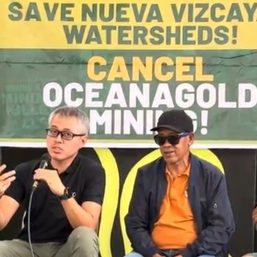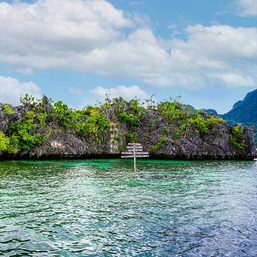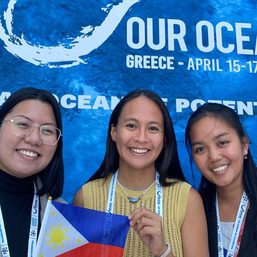SUMMARY
This is AI generated summarization, which may have errors. For context, always refer to the full article.

Grief pushed Celine Murillo to explore the outdoors.
Often loss is what links travelers and other people to seek the reprieve of nature. In 2014, Celine had to deal with the pain of losing a mother.
The death was swift and took them by surprise. Celine had already graduated from college with a degree in business management, quit her first job in an automotive company, and was going through a job interview when she received the phone call.
She arrived at the hospital to find her mother wrapped in a blanket.
For Celine, grief came and went as she traveled places. She had become all too familiar with others’ opinion that she was just running away from things.
“But I found what I needed to find when we were traveling,” Celine told Rappler in Filipino. She was sitting on a kiosk’s plastic stool inside campus grounds in Quezon City where a fair promoting organic fruits and vegetables, artisanal sugar and sea salt, was being held.
“And that’s what helped the healing, being exposed to so much beauty in the natural world. That’s where the desire kicked in to preserve it, to protect it.”
There might be others like her past self looking to heal themselves. She believes if she participated in nature’s conservation, others could experience the natural world the way she did.

Baby steps
Celine might be known now for her viral TikTok videos that introduce trees, birds, and flowers to online users.
But despite her relatively recent rise into the mainstream, Celine had been writing about her adventures outdoors in a now-defunct blog. The blog was called Celinism, where Celine wrote about her travels with her partner, Dennis Murillo.
They met in high school in Angono, Rizal, became sweethearts in 2007, and then ten years later, got married.
In the aftermath of her mother’s death, they started traveling and climbing mountains. They explored Catanduanes on a motorcycle, climbed the second highest peak in the Philippines – Mt. Pulag in the Cordilleras – and some of the lesser known mountains in Rizal province. She would get freelance writing jobs for magazines.

From 2018 to 2019, the couple joined a team that produced a documentary on the conservation of the tamaraw or the Mindoro dwarf buffalo (Bubalus mindorensis). Celine wrote the script with director Mark Ace Gatdula. Dennis provided photography and additional footage.
Editor’s Note: In a previous version of this article, the tamaraw was called Mindanao dwarf buffalo. This has been corrected.
They both consider it a milestone, with Dennis saying they were forced to learn many technicalities of long-form production. Celine had this memory tattooed on her left arm. Literally. Opposite the tamaraw tattoo is a Malabulak tree (Bombax ceiba), her favorite, on her right arm.
Pandemic and the van life
Like others, the pandemic provided time for new hobbies and learnings.
Locked in their apartment they started a container garden that attracted birds. She bought guidebooks and gears to feed this fascination for birds.
At this time, she was already working for a meditation app. Her job was to listen to the guided meditations as part of quality control. Soon she started practicing the meditations as it helped clear her head.
“Listening to the guided meditations helped us tide over the pandemic,” Celine said. “Then we understood how to manage our emotions.” She would call her husband her anchor who keeps her stable when she goes through a hard time regulating her emotions.
“We started traveling and we slowly learned what it is we want to do, what our purpose in life is.”
It was a simple, roaming life that they wanted. So when the pandemic restrictions eased, they modified a secondhand 1992 Mitsubishi Delica Starwagon, christened it Eli the Camper Van, and started a series of videos of their travels aboard Eli.
On their joint YouTube channel, they featured places like Quezon Province, Camarines Norte, Albay and the rest of the Bicol region. They went all the way down to the hometown of Celine’s mother, Sorsogon City in Sorsogon province.
In Sorsogon, a new way of life
They went around Mindanao first before settling down in Sorsogon, after the house was renovated.
By then they had lived in a van for one and a half years. Dennis, who left his job as an electrical engineer for this new life, learned and cultivated a passion for landscape photography. For these kinds of content, Celine was behind the camera filming him.
Living in a van had been a dream but one that took a lot of planning– counting their money and until when it will last.

“We started with a blank slate and slowly learned everything,” said Dennis.
“We tried many things. And then when we tried the van life, we didn’t just do landscape photography, we also did wildlife. We thought we could try having Celine in front of the camera.”
In time, their interest deepened. Celine shared they started measuring plants and flowers to ascertain its species. She explained, for example, that there are some flowers that look the same and only by measuring them can one correctly identify them.
In January 2023, they uploaded their first video on TikTok, Generation Z’s search engine. It was, Celine said, part of her New Year’s resolution to create more short-form content and reach an untapped audience.
At first their short, vertical videos were taken from their original long-form content. She was reluctant then to show her face in the short videos.
Eventually, she said in a previous The Green Report episode, she realized the value of acting like a guide to online users, providing human scale to the living things in the wild.
Her routine: Celine enters the forest and looks for a plant, a tree, or a flower that looks familiar to her and which she can identify. If she’s unsure, she asks help from botanists, ecologists, or taxonomists to vet her content.
“Then we go back to the forest and film,” she said. “So usually half a day, we can film two to four short-form videos.”
One of the people Celine consults from time to time is forester Viki Balon. She was working for the protected area management office of Mts. Iglit–Baco Natural Park in Mindoro at that time.
As a professional forester for 14 years, Balon said it was “high time” that people shift their mindset “to long-term initiatives that focus on intangible ecosystem services rather than direct economic benefits.”
For example, the introduction of exotic species in the wild was primarily “motivated by utilization and monetary factors,” said Balon.
Having a person introduce native species to Filipinos “can lead a new generation to have the same mindset of conservation with the use of indigenous species,” Balon added.
A communal future
Inside university grounds, people mill about the fair in front of Palma Hall despite the rain brought by the first storm to hit the country this year.
The booths sold fresh produce, sugar and spice, books about women written by women. There were tributes for slain botanist Leonard Co and Lumad leader Bai Bibyaon Ligkayan Bigkay. We finished the interview and headed back to the fair, where visitors crowded Celine for a picture.
Dennis stayed on the sidelines and would promptly take someone’s cell phone to take their pictures.
“What we’re doing is just a building block because we want to mobilize people to ask for accountability, influence policies in the future,” Celine was saying earlier.
One thing they wanted was the integration of teaching Philippine flora and fauna in schools’ curricula. The couple have been in talks with local governments too.

One recent meeting was with Angono local government officials, to persuade them to declare heritage trees the native ones they have identified in the town proper. Celine said the trees were close together and could create a route for future walking tours.
But these advocacies need people. A community where Celine attributes their capacity to stay idealistic in an antagonistic world.
“I feel that that’s the cure,” said Celine. “Our current system alienates us from each other. We become hyper independent.”
This is opposite to how forests thrive. In the forest no one is left behind, she said. She knows. This is a fact she’s all too familiar with.
“I ask Dennis sometimes: ‘If Mama didn’t die, will we be here?’”
To which Dennis would reply and tell her that there had always existed inside her a budding interest for the natural world. It was just a matter of time, in one way or another, that she would have ended up in this field. – Rappler.com
Quotes translated to English for brevity.
Add a comment
How does this make you feel?




![[OPINION] Grading Marcos admin’s performance on the climate agenda](https://www.rappler.com/tachyon/2024/06/grading-marcos-performance-climate-agenda-june-25-2025.jpg?resize=257%2C257&crop=441px%2C0px%2C1080px%2C1080px)

![[In This Economy] Why we need to stop the proposed Laguna de Bay expressway](https://www.rappler.com/tachyon/2024/06/Why-we-need-to-stop-Laguna-de-bay-expressway-June-28-2024.jpg?resize=257%2C257&crop=458px%2C0px%2C720px%2C720px)
![[OPINION] No room for ‘business as usual’ in era of climate emergency](https://www.rappler.com/tachyon/2024/06/no-room-business-as-usual-climate-change-june-25-2024.jpg?resize=257%2C257&crop_strategy=attention)

There are no comments yet. Add your comment to start the conversation.